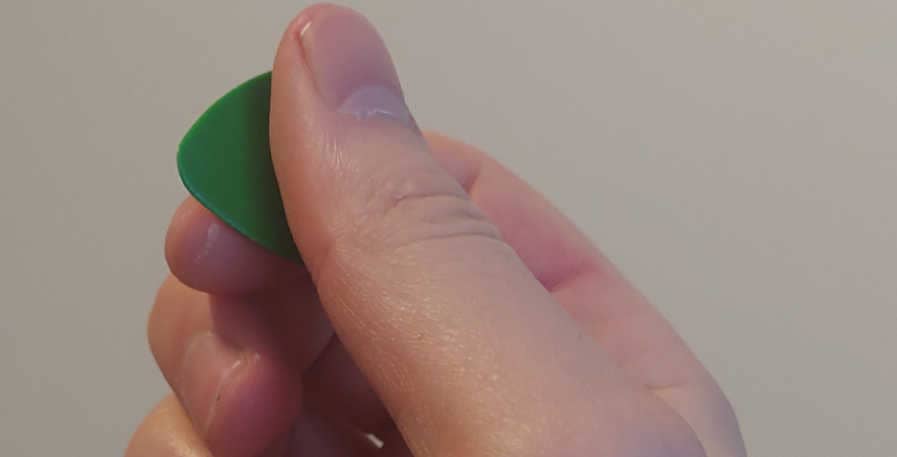How do you correctly hold a bass pick? While some might think this question is basic, I`ve seen multiple bassists mess up their technique by getting it wrong early on.
What`s worse is that I was one of them. When I first started trying out playing my 4-string with a pick I made most of the common mistakes one can make.
Luckily, I`ve cleaned my technique up through the years. That`s why I`ve written out this guide to prevent you from having to do it the hard way as I did.
I will show you how to properly hold a bass pick the easy way. Then, I`ll share some extra tips for how to maintain correct hand posture while playing. This way you will prevent injuries, and maintain a stable and consistent tone in your playing.
How do you hold a pick when playing bass?
A bass pick should be held between the thumb and index finger of your dominant hand. These fingers should cover about 50-60% of the surface area of the pick. Your hand should feel relaxed and only be partly clenched as your hold the pick.
The most important part of holding and playing with a pick is to avoid tension. Playing with a pick should never hurt. Thus, if you experience any pain in your wrist or hands it`s best to reassess your technique as soon as possible.
Related reading: Is playing with a pick bad?
It can be tempting to squeeze the pick hard, clench your hand into a fist, or stiffen your wrist when playing. This will all result in pain in your picking hand. Pain is not only unpleasant in itself, but can lead to injuries that can prevent you from playing the bass altogether down the road.
Thus, to ensure that you are holding your pick correctly, follow these steps:
1. Get in position – Partly clench your fist into a cup shape. Rest your thumb against your index finger. Avoid clenching or squeezing your fingers. Every part of your hand should be relaxed.
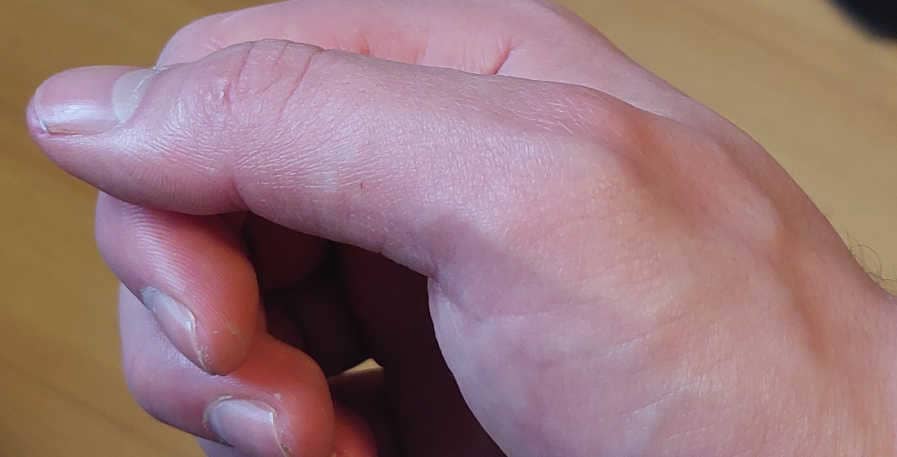
2. Slide in the pick – Now use your non-dominant hand to slide the pick in between your thumb and index finger. If you need to apply any force to fit it in, you are squeezing the thumb too hard against your index finger. The pick should gently and naturally fit between your index finger and thumb.
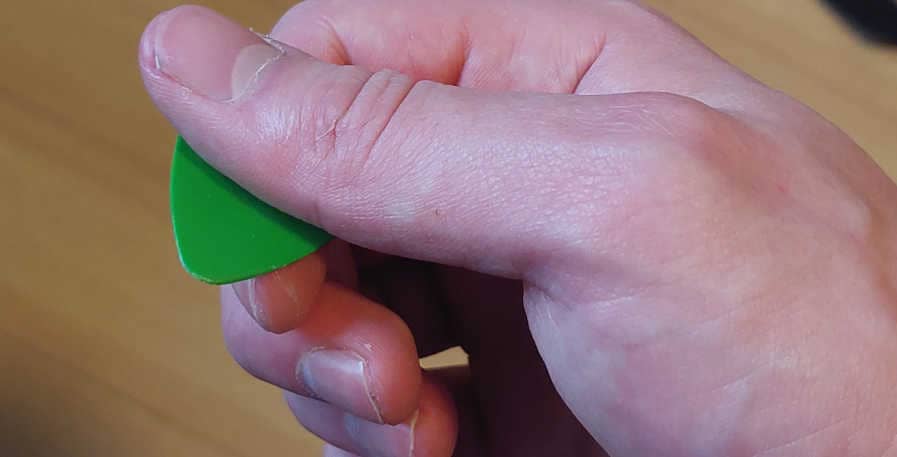
3. Mute unplayed strings – Proper muting is paramount for a clean bass tone. Therefore, your picking hand should rest against unplayed strings to keep them muted. Get in a position where you can comfortably play with the pick while using your palm and arm to keep unplayed strings from ringing out.
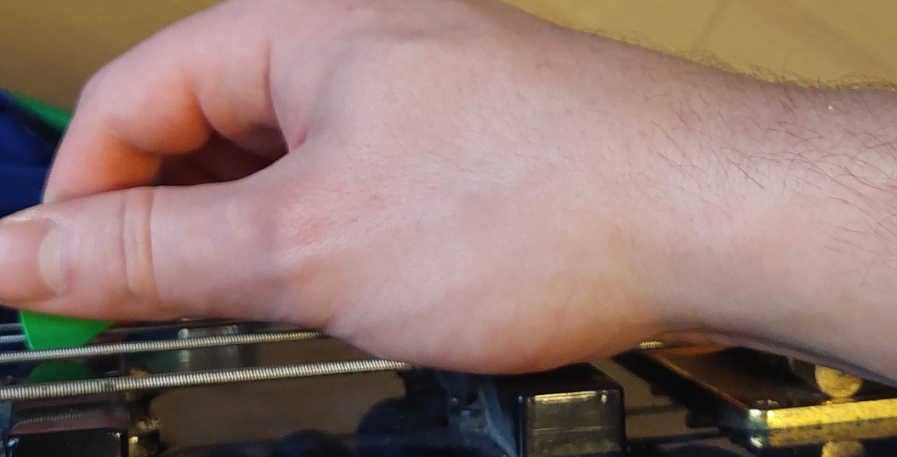
4. Move your wrist – It can be tempting to tense up your wrist, as this can enable you to play faster. However, this will also make it harder to be in control of your technique and can lead to injury. Therefore, keep your hand in the same position as above, and use your wrist and arm to move it fluidly without ever tensing up your hand.
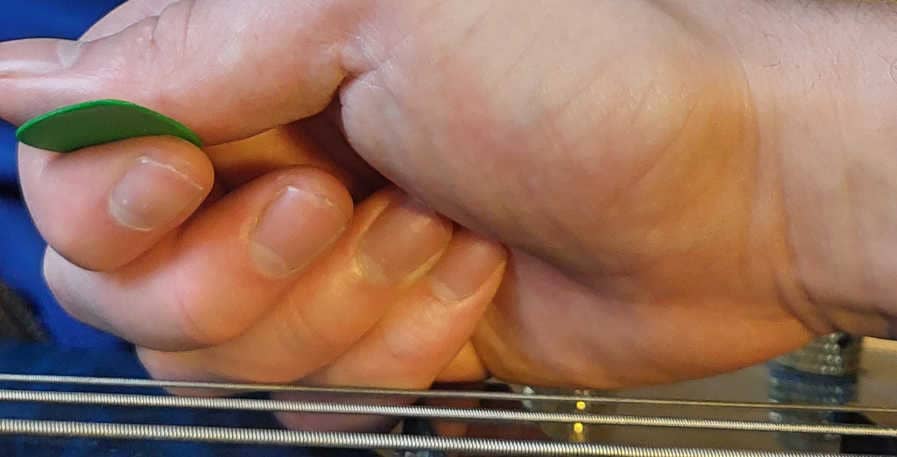
What to be mindful of when holding a bass pick
Even if you start off by holding your bass pick correctly, improper playing technique can cause your grip to slip. Therefore, it`s important to be consistent in your picking, and be mindful of when your technique starts to falter.
This is common when learning a new bass line, or playing one that pushes you to your technical limit. If you are unable to maintain a proper picking technique while playing, I recommend practicing the song slower.
As you master the bassline at a slower tempo, you can start to increase the speed and remaster the bassline. This way you will work your way towards playing the line at full speed with a controlled technique much faster than brute-forcing it at full speed from the get-go.
You also want to balance your up and downstrokes. It`s expected that they won`t sound identical, but too much force on either, and too little on the other, will make your playing sound clumsy and uneven.
You can hear this by listening to how dynamic the notes you are playing sound. If there are large, unwanted, changes in the volume, practice keeping the motion of your wrist relaxed and even.

Choose a pick that suits you
Every bass player is different. Your favorite bassist might play bass with a coin, but this doesn`t mean that it will work for you. Therefore, it`s important to try out different picks and find a size that suits you.
When doing so, there are main 3 factors to consider: the shape, material, and thickness of the bass pick. At first, I recommend focusing on finding a shape that fits you. This is because for most bassists the shape is the most important factor for how natural a pick feels to play with it.
Some bassists play with guitar picks. Guitar picks are however noticeably thinner than bass picks. This means the pick will peel back when picking strings, which can make it harder to maintain control of it.
Therefore, I recommend sampling a set of bass picks of medium thickness. This will help you find a shape that fits your style and technique and isn`t overly thick or thin.
For this purpose, I recommend this Multipack of 6 different picks from Ernie Ball. It has all of the most common pick shapes, all with a balanced thickness. The vast majority of bass players will thus be able to find a pick that fits them among the 6 picks in this set.
Conclusion
Holding a bass pick the right way is crucial for both the playability and tone of your instrument. It`s fairly basic, but getting it wrong early on can greatly hinder your overall progress as a bass player.
Once you get it down though, playing correctly with a pick has tons of advantages. It will give you more speed, control, and tonal flexibility than many other styles. Playing with a pick instead of with your fingers also prevents calluses from forming.
By following the tips outlined above you will ensure that you hold your pick correctly. It will also minimize the chance of pain and injuries, and ensures that you won`t have to fix your technique down the line.
Incorrect picking technique is a regular cause of wrist pain. In order to avoid other common causes, and to reduce pain if you are already experiencing it, continue by reading about playing bass and wrist pain.

